1 April 1778 Wednesday
Vases, Candelabra, Grave Stones, Sarcophagi. Tripods, Lamps and Ancient Ornaments volume II
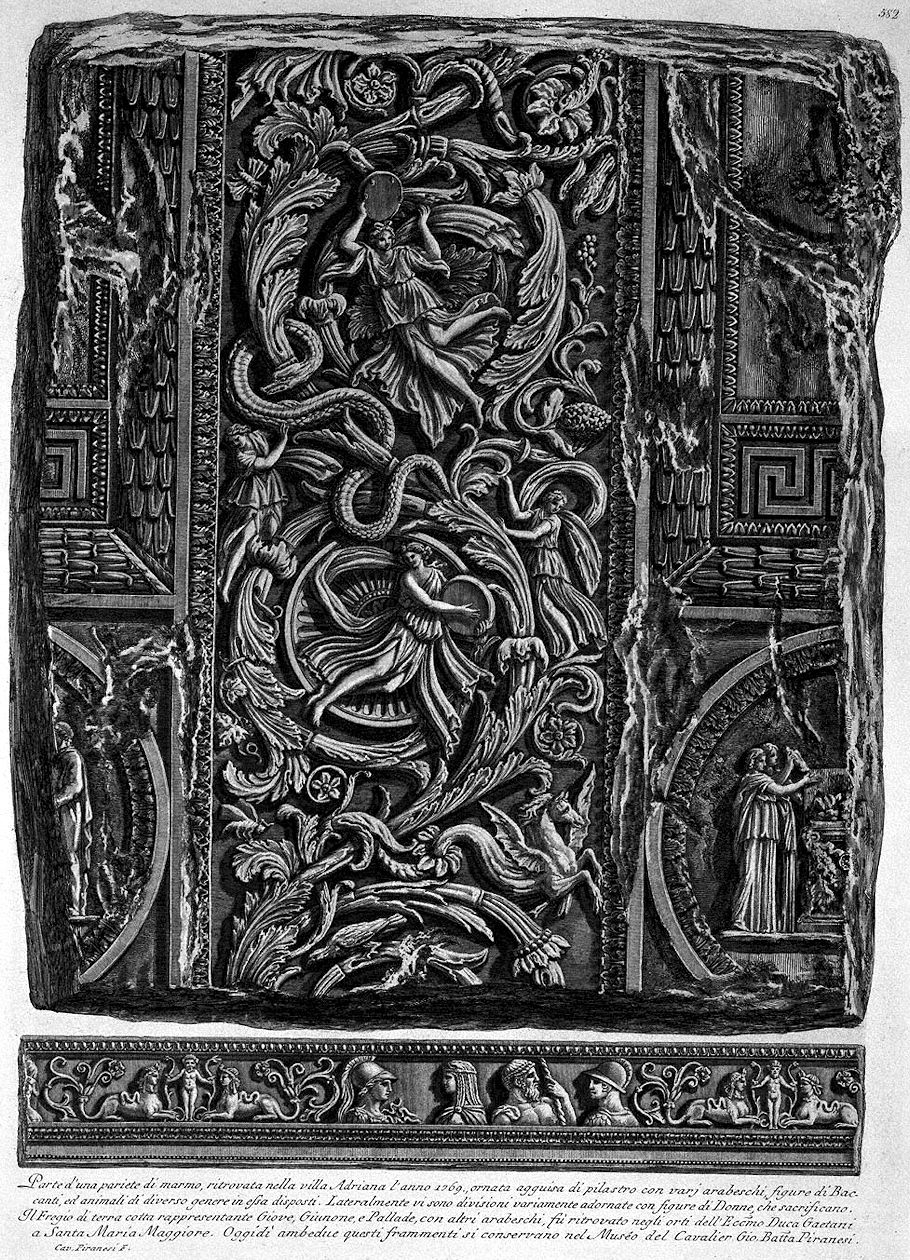
Part of a marble pariete, found in Villa Adriana in the year 1769., adorned with a pilaster with various arabesques, figures of Bacchantes, and animals of various kinds arranged in it. Laterally there are divisions variously adorned with figures of Women, who sacrifice. The terracotta frieze representing Jupiter, Juno and Pallas, with other arabesques, was found in the gardens of the Most Excellent Duke Gaetani in Santa Maria Maggiore. Today both of these fragments are kept in the Muséo del Cavalier Gio. Batt(ist)a Piranesi.
Cav. Piranesi F.
24-25 y.o. Francesco Piranesi 1783
Illumination of the Cross in St. Peter's on Good Friday
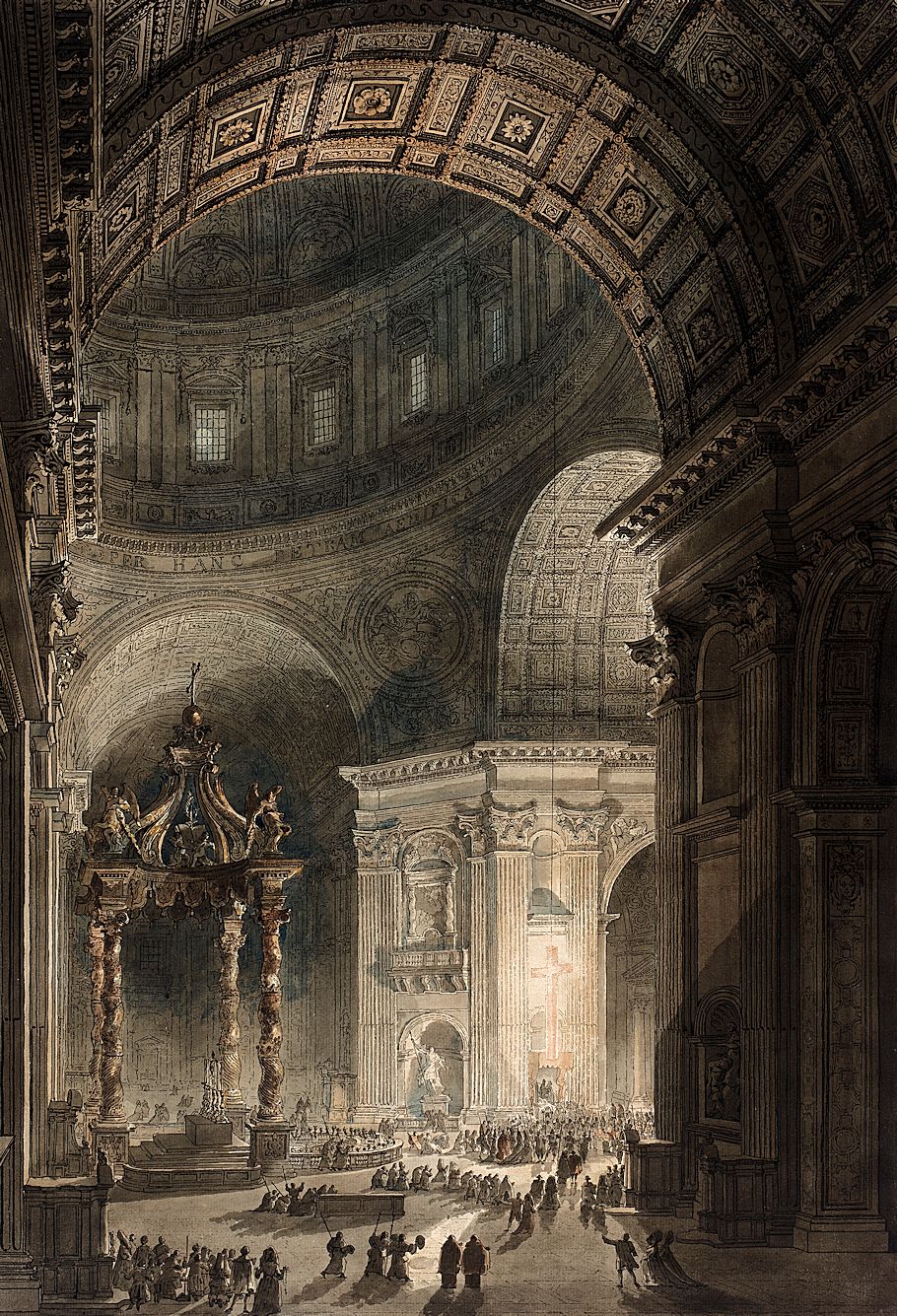
Etching by Francesco Piranesi of drawing by Louis Jean Desprez, with hand-colouring by Louis Jean Desprez.
45-46 y.o. Francesco Piranesi 1804
Calcography of the Piranesis
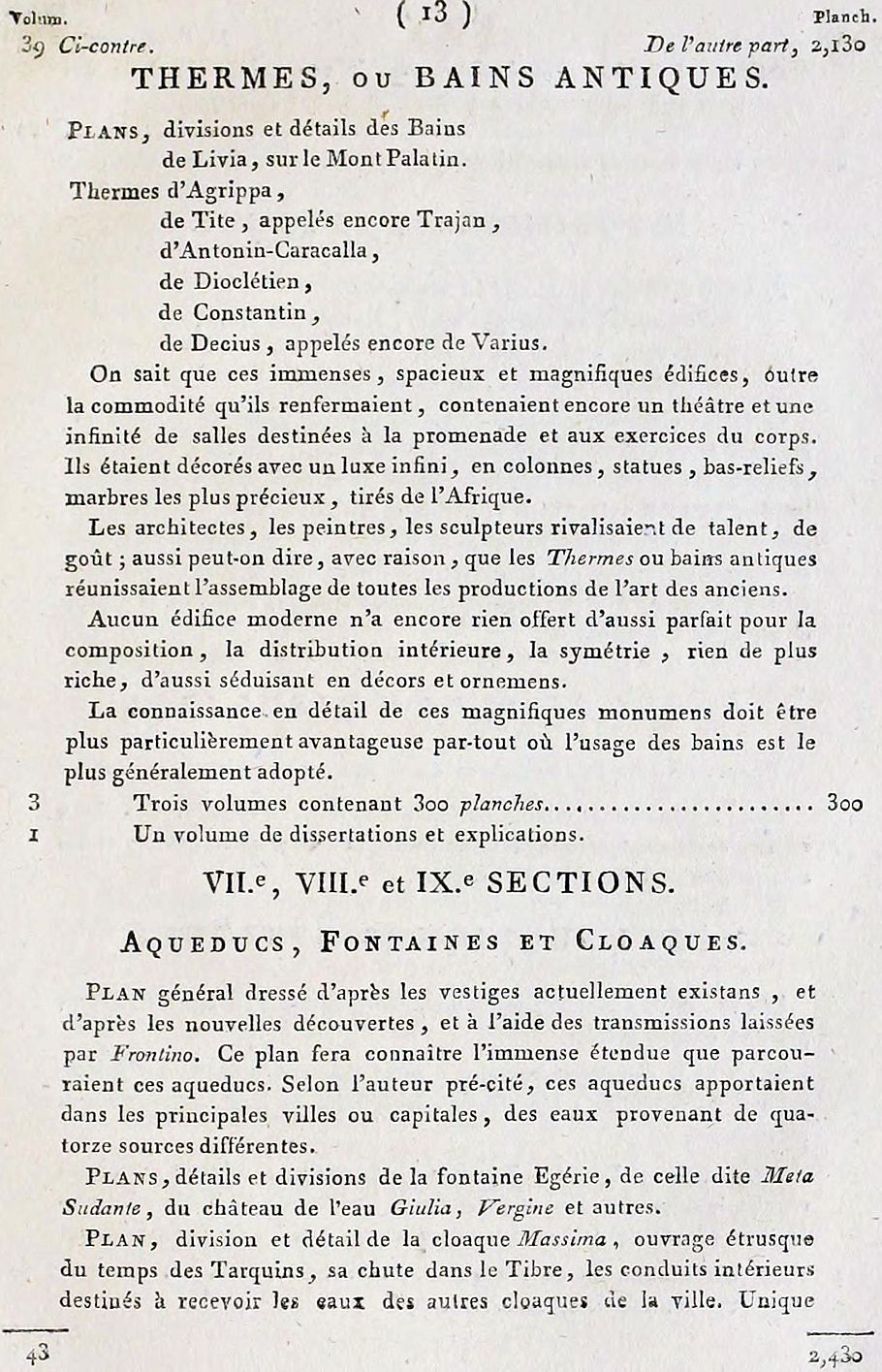
THERMAE, or ANCIENT BATHS.
PLANS, sections and details of the Baths
of Livia, on the Palatine Hill.
Baths of Agrippa,
of Titus, also called Trajan,
by Antoninus Caracalla,
of Diocletian,
of Constantine,
de Decius, also called de Varias.
We know that these immense, spacious and magnificent buildings, in addition to the convenience they contained, also contained a theater and an infinity of rooms intended for walking and physical exercise. They were decorated with infinite luxury, in columns, statues, bas-reliefs, the most precious, drawn from Africa.
Architects, painters, and sculptors all possessed talent and taste; it can also be said, with reason, that the Thermes or ancient baths brought together the assembly of all the productions of the art of the ancients.
No modern building has yet offered anything so perfect in terms of composition, interior distribution, symmetry, nothing richer, so seductive in ornamental decorations.
A detailed knowledge of these magnificent monuments should be particularly advantageous wherever the use of the baths is most generally adopted.
Three volumes containing 300 plates
A volume of dissertations and explanations.
VII, VIII, and IX SECTIONS.
Aqueducts, Fountains and Sewers.
General plan drawn up according to the vestiges presently existing, and according to the new discoveries, and with the aid of the transmissions left by Frontino. This plan will show the immense extent that these aqueducts covered. According to the aforementioned author, these aqueducts brought to the main cities or capitals, waters coming from fourteen different sources.
Plans, details and sections of the Egérle fountain, of that known as Meta Sudante, of the Giulia water tower, Vergine and others.
Plan, section and detail of the sewer, an Etruscan work from the time of the Tarquins, its fall into the Tiber, the interior conduits intended to receive the waters from other sewers in the city. Unique monument of the most remarkable for the connection, the size of the stones, the magnificence and the solidity.
A volume of 80 plates
A volume of dissertations and explanations.
1 April 1812 Wednesday
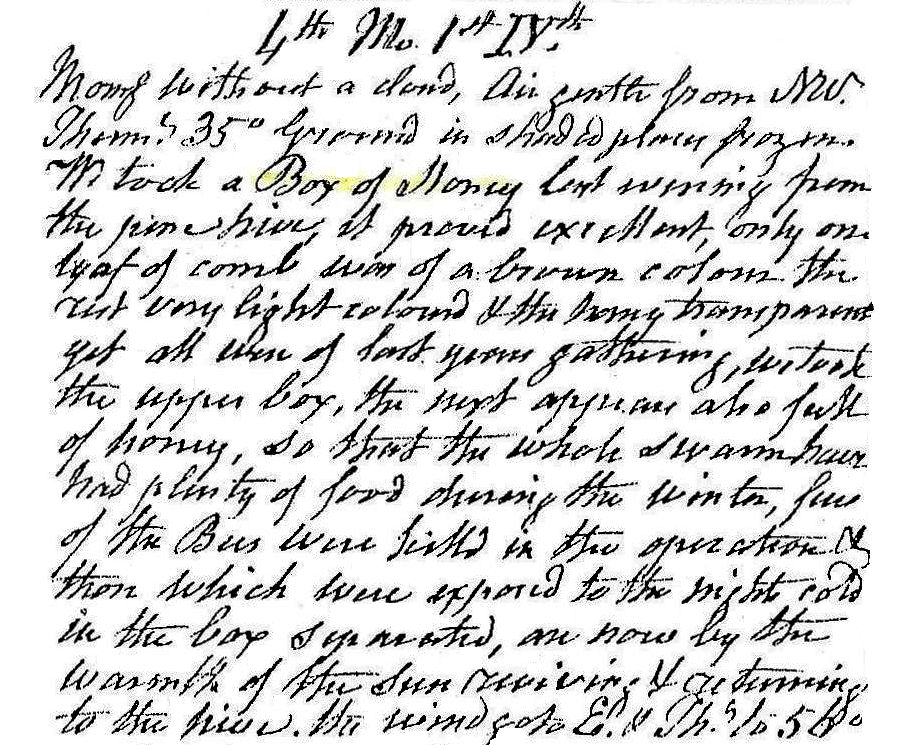
Morning without a cloud, air gentle from NW. Therm. 35°. Ground in shaded places frozen. We took a box of honey last evening from the pine hive, it proved excellent. Only one leaf[?] of comb was of a brown color, the rest very light colored and the honey transparent. Yet all seven of last year's gathering, we took the upper box, the next appears also full of honey, so that the whole swarm have had plenty of food during the winter. Five of the bees were killed in the operation, and those which were exposed to the night cold in the box separated, and now by the warmth of the sun reviving and returning. The wind got to E and therm. to 56°.
1 April 1999 Holy Thursday
a recollection of the day's events.1
My day began with an early morning Internet search of St. Agnes. I specifically wanted to locate a previously found Internet reference that attributed the original (early Christian) building of the St. Agnese basilica in Rome to Constantina, Constantine the Great's daughter. I found the St. Agnes-Constanti(n)a reference, however, during the search process I also accidentally found St. Helena, the mother of Constantine and the grandmother of Constantina. My "discovery" of Helena occurred while reading The Catholic Encyclopedia's online entry on Constantine, where there is a hyperlink to St. Helena. Seeing that Constantine's mother is a proclaimed saint naturally sparked my curiosity. The St. Helena hyperlink connects to The Catholic Encyclopedia's online entry on St. Helena herself, and it was there that I found out that it was not Constantina who was behind all the early Christian church building but rather Helena: Tradition links her name with the building of Christian churches in the cities of the West, where the imperial court resided, notably at Rome and Trier, and there is no reason for rejecting this tradition, for we know positively through Eusebius that Helena erected churches on the hallowed spots of Palestine. Despite her advanced age she undertook a journey to Palestine when Constantine, through his victory over Licinius, had become sole master of the Roman Empire, subsequently, therefore, to the year 324. It was in Palestine, as we learn from Eusebius, that she had resolved to bring to God, the King of kings, the homage and tribute of her devotion. She lavished on that land her bounties and good deeds, she "explored it with remarkable discernment", and "visited it with the care and solicitude of the emperor himself". Then, when she "had shown due veneration to the footsteps of the Saviour", she had two churches erected for the worship of God: one was raised in Bethlehem near the Grotto of the Nativity, the other on the Mount of the Ascension, near Jerusalem. Suddenly, and most unexpectedly, my (re)search turned from St. Agnes and Constantina towards St. Helena. Admittedly, I did not immediately comprehend that Helena was indeed that "builder" of the first Christian churches for which I searched, yet, within an hour of further research, I realized that Helena may well be the first "master architect" of Christianity.
1 April 2000
The Life of Pope Silvester
This centuries old text on the life of St. Silvester, selected from the Liber Pontificalis, for the most part contains one of the only records that describes ancient Rome's first Christian basilicas as erected during the reign of Constantine the Great, and most likely designed under the architectural supervision of Constantine's mother, the Empress Helena, otherwise known as St. Helena. [I was not yet aware of the role of Empress Eutropia as well.]
1 April 2004
Re: crossology
Not too long ago, countable days actually, I first learned of Melania the Younger, and how her husband's (enormously expensive) family estate [Horti Valeriani] just outside the walls of Rome at the Salarian Gate, was one of the great properties (along with the Gardens of Sallust) that were plundered when Alaric and his Visigoths broke into (at the Salarian Gate) and sacked Rome for the first time. The Visigoths initially camped for many months outside the walls of Rome (near the Salarian Gate) thereby starving the city by disrupting all deliveries of grain from Africa to the city. The Salarian Gate, the Gardens of Sallust, and the Gardens Valeriani are all delineated within Piranesi's Ichnographia Campus Martius right where they are supposed to be. Interesting, right next to this complex of buildings/structures, Piranesi also delineates a Porticus Neronianae, a completely fictitious building in the shape of a large cross within a circle (a composition, coincidentally, that follows the circle/square juncture pattern similar to the Timepiece gauge of the theory of chronosomatics). Within a day of assimilating all this new data, I came to see how the inner circle of the Porticus Neronianiae matches the circle of the compass/north arrow that Piranesi also delineated within the Ichnographia, and I came to see how if you rotate the cross of the Porticus Neronianae 45 degrees, its four points then correspond exactly to the four cardinal points of global direction. The Porticus Neronianae of Piranesi's Ichnographia Campus Martius is the X that marks the spot where the first attacking Visigoths camped. There are even more 'symbols' to interpret here, like 'shifting winds' and Nero as anti-Christ precursor, but more on that latter.
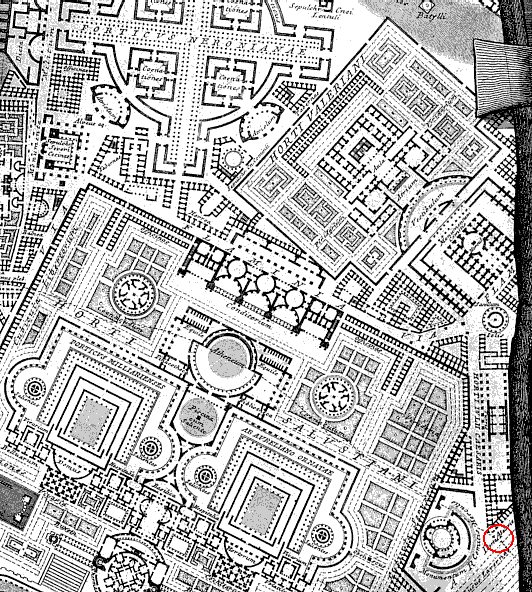
Giovanni Battista Piranesi, Ichnographia Campus Martius (1762), detail.
The Horti Valeriani is situated in the upper right corner, directly above the Horti Sallustiani, which occupies the entire bottom portion of the plan. Note that the Aurelian Wall is delineated via a bowing dotted line, which is visible directly above the words 'Horti' and 'Sallustiani'. The position of the Salarian Gate is indicated along the dotted line, here circled in red.
Origin of Ignudi
In the lower right corner of The Marriage of Constantine and Fausta tapestry designed by Rubens (1623-25) at the PMA, there is a semi-nude 'slave' holding back an entering bull by the horns. This figure is clearly a 'reenactment' of Michelangelo's ignudi figures found within the Sistine Chapel ceiling fresco (1508-12). Around the corner from where this tapestry hangs, hangs the nude portrait of Cosimo I de' Medici as Orpheus (1537-40). The label of this painting explains how the pose of Cosimo here is inspired by [and reenactment of] the Torso Belevedere. The pose of the slave within The Marriage of Constantine and Fausta and the pose of Cosimo as Orpheus are virtually identical.
from a web search of torso belvedere:
The Belvedere Torso was named after the Cortile del Belvedere in the Vatican where the sculpture was first installed by Pope Clement VII (1523-1534 A.D.) and was one of the few ancient statues discovered during the Renaissance. The artist Michelangelo reputedly referred to the torso as his "teacher."
from another web search of torso belvedere:
The Torso Belvedere, the famous torso of Hercules, in the Vatican, was discovered in the fifteenth century. It is said that Michael Angelo greatly admired it.
1 April 2006
Complex Iconography and Contradictory Content in Architecture
It's strange to think that the double basilica of Augusta Treverorum [Trier] (circa 326-8 AD) was the first Christian basilica of northern Europe, and for many years the largest Christian church of northern Europe as well. Little remains of the original double basilica, but two large churches are still there side by side today.
My theory as to why there were two joined basilicas, to begin with, is that they were designed to accommodate the distinct Latin and Greek populations of Augusta Treverorum. I also theorize the double basilica of Augusta Treverorum as the primogenitor of the Romanesque. Eutropia was the 'architect'.
While the Shroud of Turin is well known, the Holy Coat of Trier is much lesser known. Perhaps you know the movie The Robe, however. "The Trier tradition affirms that this relic was sent to that city by the Empress St. Helena." If this tradition is true, Helena was already dead when the Holy Coat was brought to Augusta Treverorum. It was Eutropia who executed the translation of the relic.
The head of Helena, empress and saint, is also in one the double churches at Trier.
Did Eutropia ultimately die at Augusta Treverorum? Albeit a Syrian, as a western Roman Empress herself, she certainly was no stranger to the city. It is at least known that Constantine was at Augusta Treverorum 27 September 328 and 29 December 328 while on a campaign on the Rhine. Coincidentally, the end of 328 and the beginning of 329 is exactly when coins depicting Helena Augusta stopped being issued. It has long been my contention that the Helena coins ceased once Eutropia had died.
How come architecture historians have yet to make the very direct connection between Constantine's throne hall at Augusta Treverorum (306 AD) and the first Christian basilica of Rome (312 AD)? Perhaps it is only obvious to Eutropia, Helena and Constantine and those who know them as to where the "basilican" form of the Early Christian Architecture actually came from.
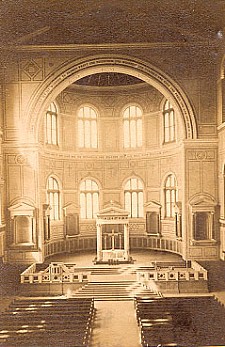 
Aula Palatina, Trier, c.306 AD.
1 April 2021
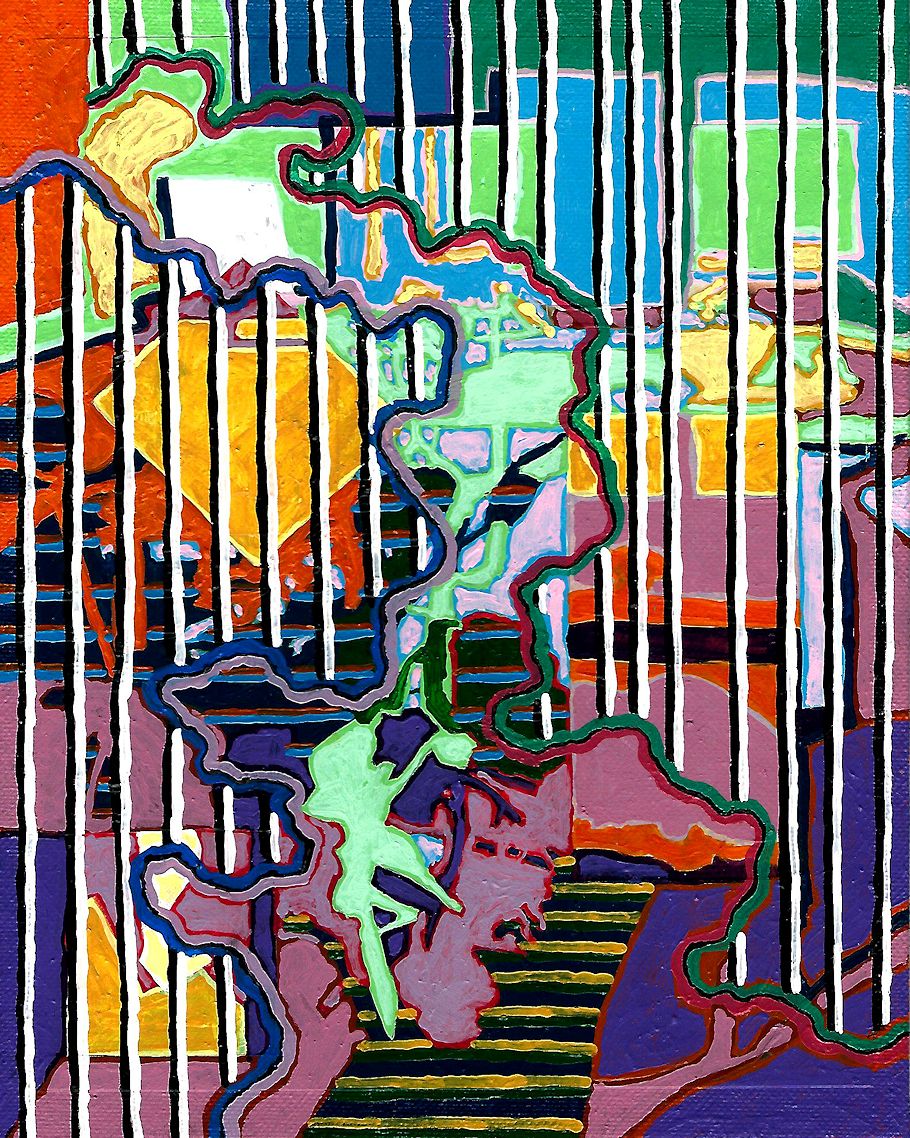
A's 58 001
1 April 2023 Saturday
6 December
ST NICHOLAS, called "of Bari", Bishop of Myra (Fourth Century)
The great veneration with which this saint has been honoured for many ages and the number of altars and churches which have been everywhere dedicated in his memory are testimonials to his holiness and of the glory which he enjoys with God. He is said to have been born at Patara in Lycia, a province of Asia Minor. Myra, the capital, not far from the sea, was an episcopal see, and this church falling vacant, the holy Nicholas was chosen bishop, and in that station became famous by his extraordinary piety and zeal and many astonishing miracles. The Greek histories of his life agree that he suffered imprisonment for the faith and made a glorious confession in the latter part of the persecution raised by Diocletian, and that he was present at the Council of Nicaea and there condemned Arianism. The silence of other authors makes many justly suspect these circumstances. He died at Myra, and was buried in his cathedral.
This summary account by Alban Butler tells us all that is known about the life of the famous St Nicholas, and even a little more: for his episcopate at Myra during the fourth century is really all that seems indubitably authentic. This is not for lack of material, beginning with the life attributed to the monk who died in 847 as St Methodius, Patriarch of Constantinople. But he warns us that "Up to the present the life of this distinguished shepherd has been unknown to the majority of the faithful," and sets about enlightening their ignorance nearly five hundred years after the saint's death. This is the least unreliable of the "biographical" sources available, and a vast amount of literature, critical and expository, has grown up around them. Nevertheless, the universal popularity of the saint for so many centuries requires that some account of these legends should be given
here.
We are assured that from his earliest days Nicholas would take nourishment only once on Wednesdays and Fridays, and that in the evening according to the canons. "He was exceedingly well brought up by his parents and trod piously in their footsteps. The child, watched over by the Church with the care of the turtle-dove for her chicks, kept untarnished the innocence of his heart." At five years old he began to study the sacred sciences, and "day by day the teaching of the Church enlightened his mind and encouraged his thirst for sincere and true religion." His parents died when he was a young man, leaving him well off, and he determined to devote his inheritance to works of charity. An opportunity soon arose. A citizen of Patara had lost all his money, and had moreover to support three daughters who could not find husbands because of their poverty; so the wretched man was going to give them over to prostitution. This came to the ears of Nicholas, who thereupon took a bag of gold and, under cover of darkness, threw it in at the open window of the man's house. Here was a dowry for the eldest girl, and she was soon duly married. At intervals Nicholas did the same for the second
and third; at the last time the father was on the watch, recognized his benefactor, and overwhelmed him with his gratitude. It would appear that the three purses, represented in pictures, came to be mistaken for the heads of three children, and so they gave rise to the absurd story of the children, resuscitated by the saint, who had been killed by an innkeeper and pickled in a brine-tub.
Coming to the city of Myra when the clergy and people of the province were in session to elect a new bishop, St Nicholas was indicated by God as the man they should choose. This was at the time of the persecutions at the beginning of the fourth century, and, "As he was the chief priest of the Christians of this town and preached the truths of faith with a holy liberty, the divine Nicholas was seized by the magistrates, tortured, then chained and thrown into prison with many other Christians. But when the great and religious Constantine, chosen by God, assumed the imperial diadem of the Romans, the prisoners were released from their bonds and with them the illustrious Nicholas, who when he was set at liberty returned to Myra." St Methodius asserts that "thanks to the teaching of St Nicholas the metropolis of Myra alone was untouched by the filth of the Arian heresy, which it firmly rejected as death-dealing poison," but says nothing of his presence at the Council of Nicaea in 325. According to other traditions he was not only there but so far forgot himself as to give the heresiarch Arius a slap in the face. Whereupon the conciliar fathers deprived him of his episcopal insignia and committed him to prison: but our Lord and His Mother appeared there and restored to him both his liberty and his office. As against Arianism so against paganism, St Nicholas was tireless and took strong measures: among other temples he destroyed was that of Artemis, the principal in the district, and the evil spirits fled howling before him. He was the guardian of his people as well in temporal affairs. The governor Eustathius had taken a bribe to condemn to death three innocent men. At the time fixed for their execution Nicholas came to the place, stayed the hand of the executioner, and released the prisoners. Then he turned to Eustathius and did not cease to reproach him until he admitted his crime and expressed his penitence. There were present on this occasion three imperial officers who were on their way to duty in Phrygia. Later, when they were back again in Constantinople, the jealousy of the prefect Ablavius caused them to be imprisoned on false charges and an order for their death was procured from the
Emperor Constantine. When the officers heard this they remembered the example they had witnessed of the powerful love of justice of the Bishop of Myra and they prayed to God that through his merits and by his instrumentality they might yet be saved. That night St Nicholas appeared in a dream to Constantine, and told him with threats to release the three innocent men, and Ablavius experienced the same thing. In the morning the emperor and the prefect compared notes, and the condemned men were sent for and questioned. When he heard that they had called on the name of the Nicholas of Myra who had appeared to him, Constantine set them free and sent them to the bishop with a letter asking him not to threaten him any more but to pray for the peace of the world. For long this was the most famous miracle of St Nicholas, and at the time of St Methodius was the only thing generally known about him.
The accounts are unanimous that St Nicholas died and was buried in his episcopal city of Myra, and by the time of Justinian there was a basilica built in his honour at Constantinople. An anonymous Greek wrote in the tenth century that, "the West as well as the East acclaims and glorifies him. Wherever there are people, in the country and the town, in the villages, in the isles, in the furthest parts of the earth, his name is revered and churches are built in his honour. Images of him are set up, panegyrics preached and festivals celebrated. All Christians, young and old, men and women, boys and girls, reverence his memory and call upon his protection. And his favours, which know no limit of time and continue from age to age, are poured out over all the earth: the Scythians know them, as do the Indians and the barbarians, the Africans as well as the Italians." When Myra and its great shrine finally passed into the hands of the Saracens, several Italian cities saw this as an opportunity to acquire the relics of St Nicholas for themselves. There was great competition for them between Venice and Bari. The last-named won, the relics were carried off under the noses of the lawful Greek custodians and their Mohammedan masters, and on May 9, 1087 were safely landed at Bari, a not inappropriate home seeing that Apulia in those days still had large Greek colonies. A new church was built to shelter them and the pope, Bd Urban II, was present at their enshrining. Devotion to St Nicholas was known in the West long before his relics were brought to Italy, but this happening naturally greatly increased his veneration among the people, and miracles were as freely attributed to his intercession in Europe as they had been in Asia. At Myra "the venerable body of the bishop, embalmed as it was in the good ointments of virtue, exuded a sweet-smelling 'myrrh', which kept it from corruption and proved a health-giving remedy against sickness, to the glory of him who had glorified Jesus Christ, our true God." The translation of the relics did not interrupt this phenomenon, and the "manna of St Nicholas" is said to flow to this day. It was one of the great attractions which drew pilgrims to his tomb from all parts of Europe
It is the image of St Nicholas more often than that of any other that is found on Byzantine seals; in the later middle ages nearly four hundred churches were dedicated in his honour in England alone; and he is said to have been represented by Christian artists more frequently than any saint except our Lady. St Nicholas is venerated as the patron-saint of several classes of people, especially, in the East, of sailors and, in the West, of children. The first of these patronages is probably due to the legend that, during his life-time, he appeared to storm-tossed mariners who invoked his aid off the coast of Lycia, and brought them safely to port. Sailors in the Aegean and Ionian seas, following a common Eastern custom, had their
"star of St Nicholas" and wished one another a good voyage in the phrase "May St Nicholas hold the tiller." The legend of the "three children" gave rise to his patronage of children and various observances, ecclesiastical and secular, connected therewith; such were the boy-bishop and, especially in Germany, Switzerland and the Netherlands, the giving of presents in his name at Christmas time. This custom in England is not a survival from Catholic times. It was popularized in America by the Dutch Protestants of New Amsterdam, who had converted the popish saint into a nordic magician (Santa Claus = Sint Klaes = Saint Nicholas) and was apparently introduced into this country by Bret Harte. It is not the only "good old English custom" which, however good, is not "old English," at any rate in its present form. The deliverance of the three imperial officers naturally caused St Nicholas to be invoked by and on behalf of prisoners and captives, and many miracles of his intervention are recorded in the middle ages.
Curiously enough, the greatest popularity of St Nicholas is found neither in the eastern Mediterranean nor north-western Europe, great as that was, but in Russia. With St Andrew the Apostle he is patron of the nation, and the Russian Orthodox Church even observes the feast of his translation; so many Russian pilgrims came to Bari before the revolution that their government supported a church, hospital and hospice there. He is a patron-saint also of Greece, Apulia, Sicily and Lorraine, and of many cities and dioceses (including Galway) and churches innumerable. At Rome the basilica of St Nicholas in the Jail of Tully (in Carcere) was founded between the end of the sixth and the beginning of the seventh centuries. He is named in the preparation of the Byzantine Mass.
Herbert Thurston, S.J. and Donald Attwater, Butler's Lives of the Saints (vol. 4, 1956), pp. 503-06.
|